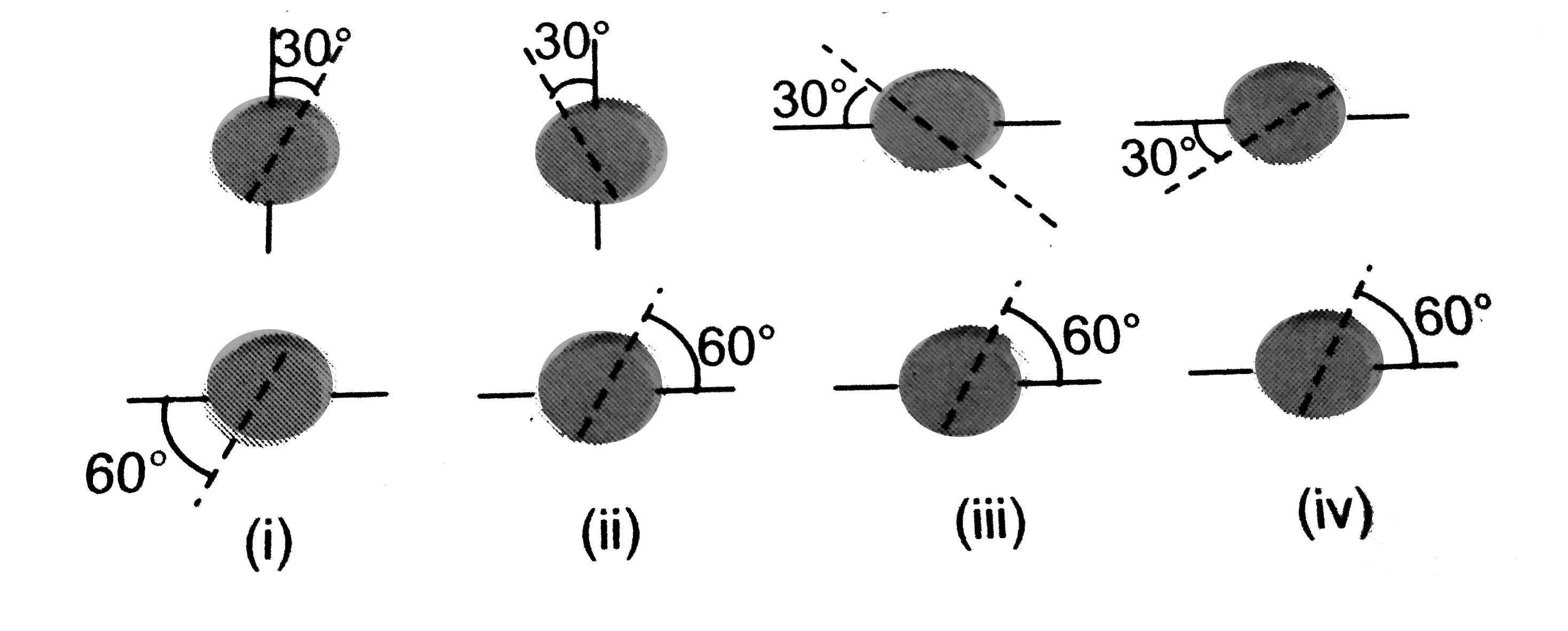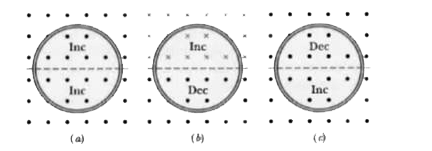The figure shows four pairs of polarizing sheets, seen face-on. Each pair is mounted in the path of initially unpolarised light. The polarizing direction of each sheet (indicated by the dashed line) is referenced to either a horizontal x-axis or a vertical y axis. Rank the pair according to the fraction of the initial intensity that they pass, greatest first

(a) (i)gt(ii)gt(iii)gt(iv)
(b) (i)gt(iv)gt(ii)gt(iii)
(c) (i)gt(iii)gt(ii)gt(iv)
(d) (iv)gt(iii)gt(ii)gt(i)
The correct Answer is:B
Final intensity of light given by Brewster's law I=I0cos2θ, where θ= Angle between transmission axes of polariser and analyser.

Topper's Solved these Questions
- WAVE OPTICSBOOK - A2ZCHAPTER - WAVE OPTICSEXERCISE - Problems Based On Different Concepts
39 Videos
- WAVE OPTICSBOOK - A2ZCHAPTER - WAVE OPTICSEXERCISE - Section B - Assertion Reasoning
23 Videos
- WAVE OPTICSBOOK - A2ZCHAPTER - WAVE OPTICSEXERCISE - Young'S Double Slit Experiment
111 Videos
- SOURCE AND EFFECT OF MAGNETIC FIELDBOOK - A2ZCHAPTER - SOURCE AND EFFECT OF MAGNETIC FIELDEXERCISE - Section D - Chapter End Test
30 Videos
Similar Questions
Figure 32-15a, drawn in perspective, shows a system of three polarizing sheets in the palh of initially uL1polarized light. The polarizing direction of the first sheet is parallel to the y axis, that of the second sheet is al an angle of 60° counterclockwise from the y axis, and thaL of the third sheet is parallel to the x axis. What fraction of the initial intensity I0 of the light emerges from the three-sheet system. and in which direction is that emerging light polarized?
View SolutionAn unpolarized light is travelling along Z axis through three polarizing sheets. The polarzing direction of the first and third sheet are respectively parallel to X axis and Y axis whereas that of the second one is at 60∘ to the Y axis. Then, the fraction of the initial light intensity that emerges from the system in about,
View Solution
Knowledge Check
An unpolarized light is travelling along Z axis through three polarizing sheets. The polarzing direction of the first and third sheet are respectively parallel to X axis and Y axis whereas that of the second one is at 60∘ to the Y axis. Then, the fraction of the initial light intensity that emerges from the system in about,
AzeroB3I032CI032D9I032A horizontal beam of vertically polarized light of intensity 43W/m2 is sent through two polarizing sheets. The polarizing direaction of the first is 60∘ to the vertical, and that of the second is horizontal. The intensity of the light transmitted b y the pair of sheets is (nearly)
A8.1W/m2B7.3W/m2C6.4W/m2D3.8W/m2A plane polarized light passed through successive polarizers which are rotated by 30∘ with respect to each other in the clockwise direction. Neglecting absorption by the polarizers and given that the first polarizer's axis is parallel to the plane of polarization of the incident light, the intensity of light at the exit of the fifth polarizer is closest to
Asame as that of the incident lightB17.5% of the incident lightC30% of the incident lightDzero
The figure shows three small spheres that rotate about a vertical axis. The perpendicular distance between the axis and the center of each sphere is given. Rank the three spheres according to their rotational inertia about that axis, greatest first.

View SolutionThe figure shows three situations in which identical circular conducting loops are in uniform magnetic fields that are either increasing (Inc) or decreasing (Dec) in magnitude at identical rates. In each, the dashed line coincides with a diameter. Rank the situations according to the magnitude of the current induced in the loops, greatest first.

View Solution50.An unpolarized light passes through three polarizing sheets whose polarizing directions make an angle of 30^(@) 60^(@) and 30^(@) with y axis in same sense.What fraction of initial intensity is transmitted by the system?
View SolutionAn unpolarized light passes through three polarizing sheets whose polarizing directions make an angle of 30∘, 60∘ and 30∘ with y axis in same sense. The tion of initial-intensity is transmitted by the system is k32. Find k.
View SolutionUnpolarised light of intensity 32Wm−2 passes through three polarizers such that transmission axes of the first and second polarizer makes and angle 30∘ with each other and the transmission axis of the last polarizer is crossed with that of the first. The intensity of final emerging light will be
View Solution
